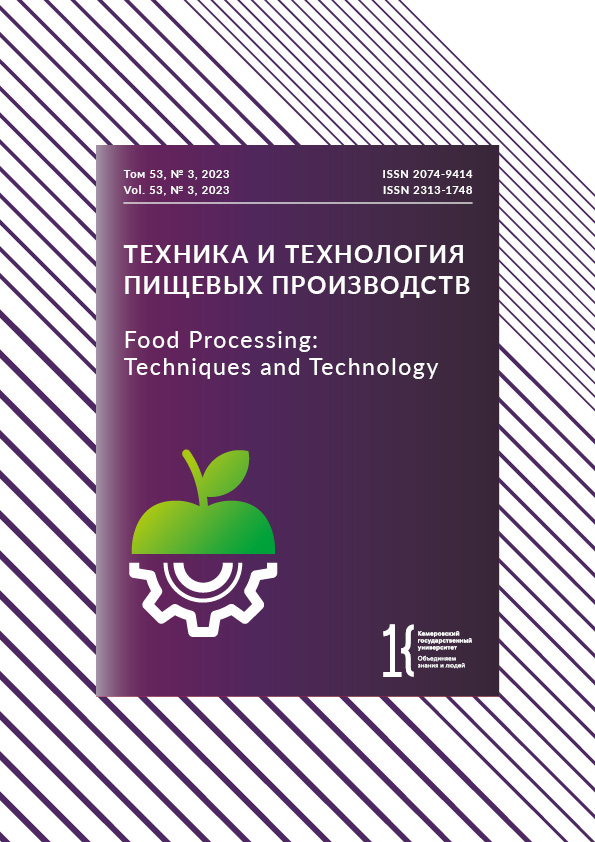from 01.01.1999 until now
St. Petersburg, Russian Federation
To keep up with the growing demand, producers of frozen plant products have to develop new freezing technologies that would preserve the sensory and biological properties of fruits and vegetables. Pectins are important structural and moisturebinding components of plant cells that improve their stability at high and low temperatures. The research objective was to study the effect of blanching and various freezing methods on the composition of pectin substances during long-term storage of fruits and vegetables. The research featured scorzonera, salsify, kohlrabi, apples, and plums. The freezing modes included two temperature modes (–24 and –35°C) and three freezing methods, i.e., blanching, air-freezing represented by natural air-freezing, artificial convection, and fluidization, and immersion in a mix of water, ethyl alcohol, sucrose, and sodium chloride. The frozen samples were stored in sealed bags at –18°C for 7–12 months. The water-soluble pectin, intermediate fraction, and protopectin obtained by extraction were determined using the colorimetric carbazole method. The qu alitative analysis relied on infrared spectroscopy. Blanching reduced the pectin content by 2–10% in vegetables and by 18–21% in apples. Fluidization and immersion freezing had the least damaging effect on pectins. Air-freezing with natural convection caused the greatest damage to protopectin. During storage, the maximal loss of pectins (66%) occurred in the salsify sample subjected to natural air convection at –24°C. The least damage (9%) was detected in the kohlrabi sample frozen at –24°C in ice environment. A higher moisture content in the native state correlated with minimal losses of pectins by the end of refrigerated storage. The research also included identification of absorption bands for pectic substances in fro zen scorzonera and salsify. In this study, pectin content depended on moisture content in tissues, blanching process, and freezing method. All frozen samples demonstrated losses of protopectin and an increase in the intermediate fraction. An intense freezing process had a positive effect on the pectin content during long-term storage. However, after six months of storage, the samples demonstrated significant fractional changes and pectin losses.
Plant products, pectin substances, freezing, blanching, infrar ed spectra, quality
1. Frozen Fruits and Vegetables Market Outlook. [Internet]. [cited 2023 Nov 18]. Available from: https://www.futuremarketinsights.com/reports/frozen-fruits-and-vegetables-market
2. Burdo OG. The role of food energy technologies in solving global mankind problems. Problems of the Regional Energetics. 2021;3(51):99–110. https://doi.org/10.52254/1857-0070.2021.3-51.09; https://www.elibrary.ru/GVEEGB
3. Raising frozen temperatures could slash emissions. [Internet]. [cited 2023 Dec 1]. Available from: https://www.coolingpost.com/world-news/raising-frozen-temperatures-could-slash-emissions/
4. Kolodyaznaya VS, Rumyantseva ON, Kiprushkina EI. The history and the prospects of food refrigeration. Journal of International Academy of Refrigeration 2023;(1):47–54. (In Russ.). https://doi.org/10.17586/1606-4313-2023-22-1-47-54; https://www.elibrary.ru/QAIWHZ
5. Fikiin K, Akterian S. A lauded refrigeration technique and resource-efficiency of frozen food industry. Trends in Food Science and Technology. 2022;128:185–187. https://doi.org/10.1016/j.tifs.2022.05.008; https://www.elibrary.ru/DZVQSP
6. Guseynova BM, Asabutaev IH, Daudova TI. Effect of freezing modes, storage time, and defrosting methods on microbiological quality parameters of apricots. Food Processing: Techniques and Technology. 2021;51(1): 29–38. (In Russ.). https://doi.org/10.21603/2074-9414-2021-1-29-38; https://www.elibrary.ru/EIHBAN
7. Schudel S, Prawiranto K, Defraeye T. Comparison of freezing and convective dehydrofreezing of vegetables for reducing cell damage. Journal of Food Engineering. 2021;293:110376. https://doi.org/10.1016/j.jfoodeng.2020.110376
8. Korotkiy IA, Sakhabutdinova GF. Improvement and analysis of processes of vegetable mixture low-temperature processing. Kholodilnaya Tekhnika. 2019;(9):51–55. (In Russ.). https://www.elibrary.ru/ONMKRO
9. Jha PK, Xanthakis E, Chevallier S, Jury V, Le-Bail A. Assessment of freeze damage in fruits and vegetables. Food Research International. 2019;121:479–496. https://doi.org/10.1016/j.foodres.2018.12.002
10. Gubanenko GA, Pushkareva EA, Rechkina EA, BalyabinaTA, KorbmakherTV, Strupan EA. The study of indicators on quality of pectins from secondary plant raw materials of Krasnoyarsk region. Conference Series: Earth and Environmental Science. 2021. https://doi.org/10.1088/1755-1315/640/6/062021
11. Sergeev AI, Kalinina IG, Shilkina NG, Barashkova II, Gradova MA, Motyakin MV, et al. Effect of elevated storage temperatures on the physicochemical and sensory properties of apple puree. Food Processing: Techniques and Technology. 2023;53(2):259–271. (In Russ.). https://doi.org/10.21603/2074-9414-2023-2-2430; https://www.elibrary.ru/SDZLSC
12. Li Y, Zhao H, Xiang K, Li D, Liu C, Wang H, et al. Factors affecting chemical and textural properties of dried tuber, fruit and vegetable. Journal of Food Engineering. 2024;365:111828. https://doi.org/10.1016/j.jfoodeng.2023.111828.
13. Kameshwar AKS, Qin W. Structural and functional properties of pectin and lignin–carbohydrate complexes de-esterases: a review. Bioresources and Bioprocessing. 2018;5(43). https://doi.org/10.1186/s40643-018-0230-8
14. Satapathy S, Rout JR, Rout JR, Kerry RG, Santi T, Sahoo SL. Biochemical Prospects of Various Microbial Pectinase and Pectin: An Approachable Concept in Pharmaceutical Bioprocessing. Frontiers in Nutrition. 2020;7:117. https://doi.org/10.3389/fnut.2020.00117
15. Feng S, Bi J, Laaksonen T, Laurén P, Yi J. Texture of freeze-dried intact and restructured fruits: Formation mechanisms and control technologies. Trends in Food Science and Technology. 2024;143:104267. https://doi.org/10.1016/j.tifs.2023.104267
16. Kolodyaznaya VS, Sokolov VN. Mass transfer characteristics during freezing of vegetable products in ice slurry. Refrigeration Technology. 2004;93(3):5–8. (In Russ.).
17. Deryabina SS. Technology for freezing stone fruits in liquid coolants. Author’s abstract. Ph.D. Tech. Sci. St. Petersburg: St. Petersburg State University of Refrigeration and Food Processing Technologies, 2003. 16 p. (In Russ.). https://elibrary.ru/NHMEIF
18. Peregudova DA, Kolodyaznaya VS, Skuridina DA. Kinetics of pectinaceous substances’ transformation reactions of autumn grades’ apples during storage at low positive temperatures. Journal of International Academy of Refrigeration. 2018;(2):48–54. (In Russ.). https://doi.org/10.17586/1606-4313-2018-17-2-48-54; https://elibrary.ru/XYOYVF
19. Donchenko LV, Firsov GG. Pectin: basic properties, production, and application. Moscow: DeLi Print, 2007. 276 p. (In Russ.).
20. Muthukumarappan K, Marella C, Sunkesula V. Food freezing technology. In: Kutz M, editor. Food freezing technology Handbook of Farm, Dairy and Food Machinery Engineering. New York: Delmar; 2019. pp. 389–415. https://doi.org/10.1016/B978-0-12-814803-7.00015-4
21. Dalvi-Isfahan M, Jha PK, Tavakoli J, Daraei-Garmakhany A, Xanthakis E, Le-Bail A. Review on identification, underlying mechanisms and evaluation of freezing damage. Journal of Food Engineering. 2019;255:50–60. https://doi.org/10.1016/j.jfoodeng.2019.03.011
22. Sun L, Zhu Z, Sun D-W. Regulating ice formation for enhancing frozen food quality: Materials, mechanisms and challenges. Trends in Food Science and Technology. 2023; 139:104116. https://doi.org/10.1016/j.tifs.2023.07.013
23. Semenov EV, Nikitin IA, Belozerov GA, Suchkov AN. Calculation of the process of freezing of a moisture-containing substance. Chemical and Petroleum Engineering. 2023;58(9-10):721–731. https://doi.org/10.1007/s10556-023-01154-z; https://elibrary.ru/IEBZJC
24. Frozen food in a resilient and sustainable food system. [Internet]. [cited 2023 Dec 18]. Available from: https://www.sustainablecooling.org/wp-content/uploads/2023/11/The-Three-Degrees-of-Change_Summary-Report_November-2023.pdf











